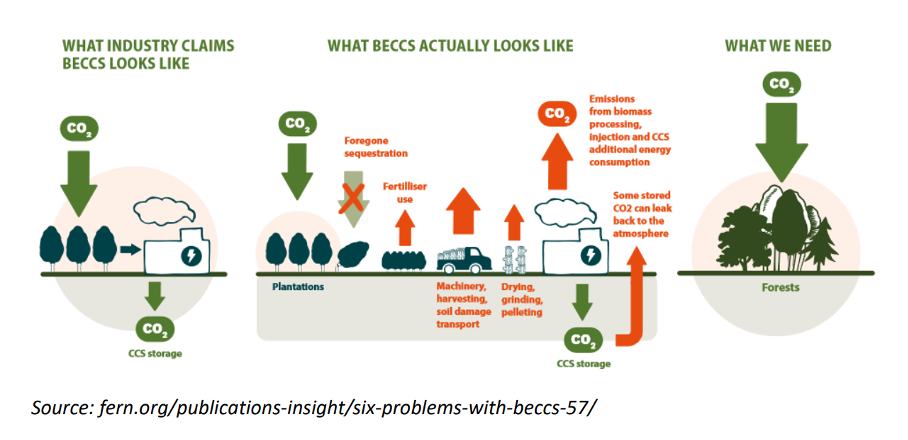RWE Eemshaven power plant runs entirely on biomass is disastrous
“Biomass combustion with CO2 capture and storage is an unproven technology, very expensive, very energy-consuming, and disastrous for forests and nature. Science has been indicating this for a long time.” This is stated by the Clean Air Committee (CSL) in response to the initiative of energy company RWE Eemshaven to run its coal-fired power plant entirely on biomass with CO2 capture and storage after 2030. Together with foreign forest protection organizations, the Committee responded to the start of an EIA procedure for the conversion of the RWE coal-fired power station.
In September, RWE Eemshaven coal-fired power plant announced that it would draw up an environmental impact report (EIA) for the conversion of the coal-fired power plant to 100% biomass combustion with CO2 capture and storage (abbreviated BECCS). CSL and foreign forest protection organizations from the US and the Baltic states immediately submitted an opinion on this to the competent authority of the province of Groningen. In the opinion they discuss in detail the disastrous effects of RWE’s disastrous plan for climate, biodiversity and air quality. CSL cites the many scientific studies and reports that discuss the disastrous effects.
Triple import of biomass
RWE wants to burn no less than 6 million tons of biomass every year. Assuming the burning of wood, this means that within 7 years the entire Dutch forest would have been cleared and burned. The biomass will come from the forests of the Baltic states and the south-east of the US. These forests are already severely affected by the annual import of 3.5 million tons of biomass for the current co-firing in the four Dutch coal-fired power stations. The RWE Eemshaven initiative would triple this quantity.
Definitely not a CO2 vacuum cleaner
In its commentary, CSL cites the many scientific studies and reports stating that the so-called ‘climate measure’ BECCS actually emits CO2 instead of capturing it. For example, scientist Dr. Tim Searchinger from Princeton University (USA) made this clear again during the Biomass Roundtable discussion in the House of Representatives on June 155. At BECCS, the energy sector deliberately overlooks a number of major CO2 emissions. As a result, biomass combustion with CO2 capture and storage is incorrectly called CO2-negaKef. The energy sector deliberately omits the following major CO2 emissions (see also appendix 3):
- CO2 losses occur in the chain prior to biomass combustion. Soil oxidation takes place when forests are cleared. Making and drying wood pellets requires energy, as does transporting it from the US and the Balk states. This CO2 is not captured. According to Searchinger, this amounts to approximately half of the CO2 emissions over the entire chain (from logging to combustion).
- Capturing and storing CO2 during biomass combustion requires a lot of energy. About a third of the energy is generated by burning wood. In addition, the efficiency of CO2 capture will not be 100%, but 80-90%.
- Biomass combustion in itself is not CO2 neutral, which is what the energy sector claims. The regrowth of planted trees takes 50 to 100 years. Trees remove CO2 from the air – the vacuum cleaner effect – only occurs after many decades. At least if planting or regenerating felled forests actually takes place.
Scientists statement
A group of approximately 90 scientists also stated this to the British government in 2021 following the intention of the world’s largest biomass power plant Drax (7 million tons of biomass combustion per year) to build CO2 capture and storage. Something that has not yet happened due to the very high costs6.
Completely unproven technology
In its opinion, CSL states that the capture and storage of CO2 during biomass combustion is a completely unproven technique. CO2 capture in a number of pilot projects at coal-fired power stations has been stopped temporarily due to technical and financial problems. The United NaKes, the InsKtute for Energy Economics and Financial Analysis (IEEFA) also reject BECCS technology (see Appendix 2).
Clean Air Committee is asking the province of Groningen to include a very thorough analysis of CO2 capture and storage projects in RWE’s environmental impact report.
Attachments:
- Opinion of CSL cs regarding NRD BECCUS RWE Eemshaven
- Studies and reports on the adverse effect of BECCS 3. Schematic representation of CO2 emissions BECCS
1. Opinion of CSL cs regarding NRD BECCUS RWE Eemshaven
Link to CSL cs’ opinion (dated October 24, 2023) regarding the advice to be adopted for the scope and level of detail for the EIA “Adaptation of RWE coal-fired power plant to 100% biomass and CO2 capture”. Clean Air Committee, Dogwood Alliance (USA) and Save Estonia’s Forests.
2. Studies and reports on the adverse effect of BECCS
United States of America: https://www.eenews.net/articles/u-n-slams-carbon-removal-as-unproven-and-risky/
IEEFA (Institute for Energy Economics and Financial Analysis): https://ieefa.org/resources/carbon-capture-remains-risky-investment-achieving-decarbonisation: “The energy sector had the worst results: two failed and one was shut down. There is not one successful project in this sector.”
FERN: https://www.fern.org/fileadmin/uploads/fern/Documents/2022/Six_problems_with_BECCS_-_2022.pdf
https://natuurenmilieu.nl/nieuws-artikel/onderzoek-naar-methodes-om-co2-uit-de-lucht-te-halen-technologische-opties-beperkt/
3. Schematic representation of CO2 emissions BECCS
FERN, 2022

